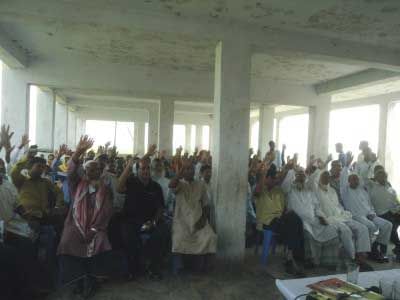Preserving biodiversity through bio-village

Bio-villagers attending a monthly meeting.
Bio-village means a village/territory where community people would live and breathe in nature and foster the biodiversified ecological balance. In this environment, they will practice organic farming, where natural fertilizers and seed could be used.
Most important features for considering a bio-village are: Ensuring protection of water resources, best utilization of cultivated land, conservation of environment and ecological balance, local/original fishery cultivation, poultry rearing, tree plantation. New technology and innovation must be practiced for monitoring the impact of these on total ecological and agricultural development, followed by using IPM and bio-pesticide; emphasizing environment friendly horticulture and crop cultivation; ensuring health, hygiene, fresh water supply and sanitation, infrastructure development and ensuring supply of energy, power and utility services.
Bio-village is an ideal model for everlasting sustainability of economy, community development and environmental sanctuary issues. BSafe and International Rice Research Institute jointly have taken an ideal to set up a model bio-village combining three villages of Manikgang. Apiculture and bee keeping as income generating activities, -vermi-compost preparation and its utilization, neem tree plantation, bio pesticide, use of importance of medicinal herb planting are important features of this bio-village project .
Danestapur, Kuestara and Kantapara, the three villages of Bolra Union under Horirampur Thana of Manikgonj have been projected for setting up the bio-village construction of which would be the first formal bio-village project in Bangladesh.
Dr. M.Zainul Abedin, IRRI Representative for Bangladesh said, “Needless to say, environment friendly cultivation would uplift the farming and increase the crop production. IRRI's contribution to Bangladesh agriculture has passed 50 years already. Over this time we have been trying to innovate new genre of rice, bio technologies and others. But the project of bio-village is a new initiative".
Dr. Abedin further commented, “This project would create income generation in the three villages along with other areas and also women empowerment is a great factor inherent in this".
Initially, about 1200 families of the three project villages will be directly involved and indirect empowerment will also be created when the infrastructure development would take place.
DKK Social Fishery Project is another feature of this village where fish cultivation will be practiced in the farmlands during the rainy season. Cultivation in floodplains areas would increase the soil fertility and decrease the total cost of agricultural crop production.
Sakiul Millat Morshed, Executive Director of SHISUK a local partner NGO considered “this project simultaneously would project the agriculture and fishery as well as pave way for nourishment of the young generation. When the project would be successful, it will be an ideal inspiration to set up more bio villages in rural areas".
Md. Ataur Rahman, Country Director of Hunger Free World considered “this project would definitely provide safety, security and certainty for better life and conservation of biodiversity as well as ecological balance. As our country is facing a negative impact of the climate change, this initiative would obviously and dynamically formulate an environment friendly and economically viable condition for the rural people.
Bio-village is a part of IRRI Bangladesh's Sustainable Soil Management initiative for food security of poor, marginal and small farmers of active flood plains and char lands of Bangladesh (SUSFER ) project. This project has been taken to improve food security and increase the supply of nutritionally rich food to poor, marginal and small farming households of the active flood plains and char lands under the project areas. Capacity building of farmers and best utilization of existing resources is the key to achieve sustainable growth in agriculture. SUSFER project is working to strengthen farming activities by transferring technologies and implementing new initiatives, of course, environment friendly.

 For all latest news, follow The Daily Star's Google News channel.
For all latest news, follow The Daily Star's Google News channel. 



Comments